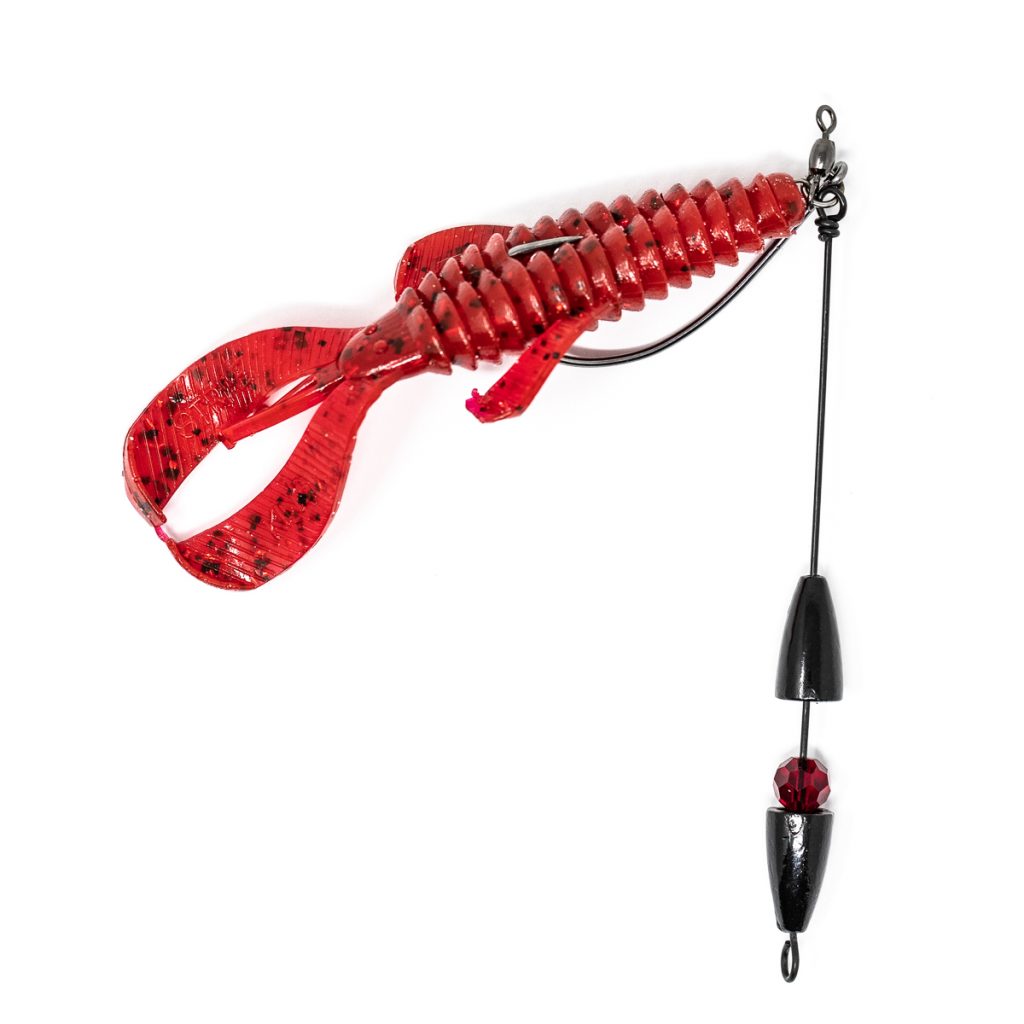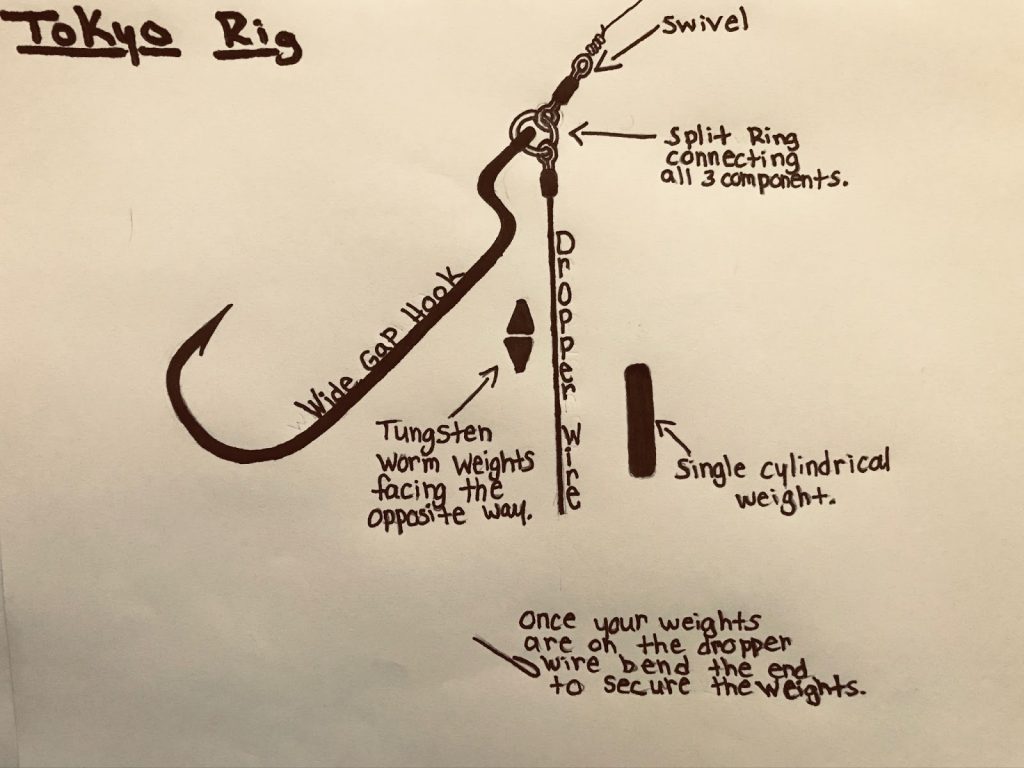The Tokyo Rig is one of the newer rigs to hit the American professional bass scene and it looks like it is here to stay. I’m not sure exactly how long this rig has been used in Japan but professional angler Mike Iaconelli came across it during a Tokyo fishing trip in 2017. He immediately saw the potential of this upgraded cross between a punch shot and a Jika rig and brought the idea back to the states. He brought it back through his collaboration with VMC hooks and it has been gaining popularity ever since.
What is a Tokyo Rig?
As you can see the Tokyo Rig resembles a Jika Rig except for a couple of seemingly minor differences. The Tokyo Rig uses a barrel swivel to tie the line to rather than tying it directly to the split ring. By not tying your line directly to the split ring you get a more natural and realistic movement from your bait.
However, the main difference between the Tokyo and Jika is that this rig uses a wire leader to secure the weights instead of attaching them directly to the split ring. This innovation serves to solve a problem that anglers commonly face when fishing the bottom – that problem is that bass don’t like to eat bait that is laying down on the bottom, especially if it’s soft and muddy. A Tokyo Rig’s wire leader acts as an anchor to your soft bait and allows the bait to remain suspended above the weights even when they are in the soft muddy bottom.
I was skeptical at first, but the Tokyo Rig quickly became one of my favorite rigs to throw when I was out on the water. From my experience, it is one of the easiest rigs to set up and it is super versatile in its application making it a great rig for the beginning angler. The Tokyo Rig’s ability to punch through thick cover allows it to go places that other rigs just can’t reach. This bait has one of the craziest hook ratios I have ever seen but we’ll get into that later. Keep reading if you want to find out why people everywhere are going crazy for the Tokyo Rig because I am going to cover everything you need to know about it in this Ultimate Guide to Tokyo Rig fishing.
Recommended Best Tokyo Rig Gear
Setting up a Tokyo Rig
If you are a lazy angler who would rather spend their time fishing instead of setting up rigs then I refer you back to the VMC and Mike Iaconelli collaboration I mentioned earlier. These premade rigs are as good as it gets and they come equipped with the best equipment available for a long-lasting rig you can count on straight out of the package. Their standard model comes in 2/0 – 5/0 hook sizes and their Light model comes in 1/0-5/0 sizes, so you can be prepared for any situation. Another benefit to purchasing these premade Tokyo Rigs is that they come with a solid ring instead of a true split ring, this serves to prevent any unnecessary line twisting and it makes for a longer-lasting rig.
The alternative to purchasing premade Tokyo Rigs is of course making one yourself. When you make something yourself you have the benefit of being able to make it specific to your standards and style of fishing, but you can’t beat the convenience of having a few premade Tokyos ready for a quick bait change.
Making a Tokyo Rig by hand requires you to have an extra-wide gap hook, a split ring, swivel (optional,) a wire, and a pair of needle-nose pliers.
You use the pliers to bend the wire through the split ring and wrap it around itself on the other side.
Next, you want to open the split ring so you can put the hook on. If you plan on using a swivel on your homemade Tokyo rig then you would put that on here as well. That’s all there is to it – anybody can make this rig and I recommend everybody try fishing one if you haven’t already. Now that you know how to set up a Tokyo Rig I am going to cover the specifics of the individual components and the ideal situation for each.
Tokyo Rig Hooks
VMC currently has two models of their premade Tokyo Rigs – they have the standard model which comes in 2/0-5/0 hooks and they have a Light model that comes in 1/0-5/0 hook sizes. I prefer the standard model 4/0 hooks for most of my Tokyo Rig fishing but the 1/0 Light model is great for swimming those smaller trailers in and out of weed beds.
Tokyo Rig Weights
There are two different weight setups that I like to use when fishing this rig. When I am bouncing the Tokyo along a rock bed I like to use two tungsten worm weights facing the opposite direction on the wire leader. Tungsten weights are known for making more noise than lead weights, and when you put two of them on the leader like this it allows them to slide up and down, clicking off of each other for that little bit of added noise. When I’m trying to punch the Tokyo Rig through thick grass and heavy cover I opt for a ½ or ¾ ounce tungsten cylindrical weight.
Part of the appeal of the Tokyo Rig is the placement of the weights in regards to the hook. This is where that crazy high landing ratio I mentioned earlier comes into play – by having the weights suspended below the hook you never have to worry about them forcing the fish’s mouth open. It helps to understand this by thinking of a Texas rig and how the weights are generally sucked into the bass’s mouth along with the bait. When you are using large weights to punch through the cover and the fish takes the weight with the bait you run a high chance of prying the fish’s mouth open when you set the hook. This problem is non-existent with the Tokyo Rig and as a result, you can count on killer hook placement and landing more fish.
How to Fish a Tokyo Rig
Tokyo Rig fishing has proved itself under most conditions and it is one of my most recommended rigs for beginner anglers. It is easy to set up, and with its snagless properties, it’s even easier to fish.
It is one of the most versatile rigs out there and can be used to punch, vertical drop, it can be flipped into heavy cover, and all kinds of other fishing techniques. I use a Tokyo Rig to punch through heavy grass more than anything else, but It is one of my favorite flipping rigs as well.
If you are using the Tokyo Rig to punch through deep grass and cover you want to make sure that you at least have a ½ ounce weight. You can add more if a ½ ounce weight doesn’t seem to be enough to penetrate the cover you are fishing.
When retrieving a Tokyo Rig, you will want to keep a semi-slack line to get the ideal movement out of your bait. This means your line isn’t going to be tight but it isn’t going to be floating on the surface either. What this does is allow you to bounce your bait through that bottom cover all while increasing the exposure time to a certain area. When you bounce a Texas Rig along the bottom it moves through the water back to the boat very quickly but the Tokyo stays in one place longer allowing you to keep that bait in front of the fish for that extra time needed for them to strike.
When to Fish a Tokyo Rig
Not only is the Tokyo Rig versatile in the style in which you fish it but it’s versatile when it comes to seasons as well. It can be fished all year long and has the ability to punch through any cover to get to the fish regardless of where they are. My general strategy when throwing a Tokyo is just to follow the fish. In the colder months, I follow the bass out to deeper water and as the temperature warms up I’ll follow them back in. I target the same type of cover regardless of the season taking a particular interest in grass lines along drop-offs.
Best Lure for Tokyo Rig
Fish of the world’s waters tend to remind me of people in the way that they all prefer to eat something different, and this preference has patterns that can be determined by geographical location. On the same given day, a bass in California water is going to target different meals than a bass of the same size in a Florida lake. What I am trying to get at here is that your lure choice is very much going to depend on where and when you are fishing.
When I am fishing a Tokyo Rig through deep grass cover I like to throw a soft plastic lizard or worm. I tend to gravitate towards darker colors like a green pumpkin but will change according to the situation. I find that plastics with an orange underside work great in areas where the bluegill population is high.
If I am fishing this rig somewhere with a rocky bottom with little to no grass I will start by trying to match whatever baitfish I notice that are in the area. If I am fishing somewhere that I am unfamiliar with I find that flipping a creature or a craw on the Tokyo is a great tactic for rock fishing.
As with most of my smallmouth fishing, I find that they can’t resist the flowing tendrils streaming from the back of a Tokyo Rigged Tube. The color choice here is going to depend on water clarity and whatever the smallies seem to be eating on.
Get Your Hands On This Rig
If You’re here reading this I am going to assume that you heard about the Tokyo Rig, maybe you’ve heard a bunch of people talking about it and you had to figure out what all the buzz was about. Either way, I hope I helped you get a better understanding of this new rig and how you should approach tying one on. This rig catches fish and I truly believe it is here to stay so please, if you haven’t already, get some Tokyo Rigs – thank me later.


















